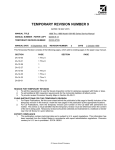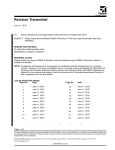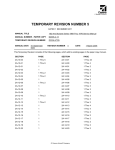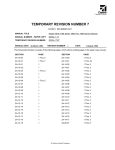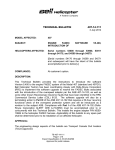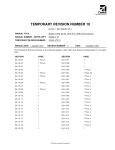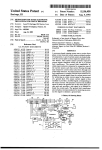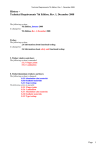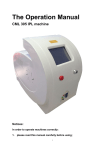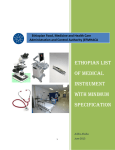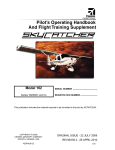Download D2064-1TR8 - Cessna Support
Transcript
TEMPORARY REVISION NUMBER 8 DATED 18 MAY 2015 MANUAL TITLE Model 152 Series 1978 Thru 1985 Service Manual MANUAL NUMBER - PAPER COPY D2064-1-13 TEMPORARY REVISION NUMBER D2064-1TR8 MANUAL DATE 7 February 1985 REVISION NUMBER 1 DATE 2 October 1995 This Temporary Revision consists of the following pages, which add to existing pages in the paper copy manual. SECTION PAGE 2A-10-01 1 thru 8 2A-12-22 1 2A-14-00 1 thru 4 2A-14-11 1 thru 3 2A-14-22 1 thru 2 2A-30-01 1 thru 13 REASON FOR TEMPORARY REVISION 1. To add additional SID inspection requirements for the vertical stabilizer on 152 model series airplanes. 2. To provide revised Corrosion Severity Maps in Section 2A-30-01. FILING INSTRUCTIONS FOR THIS TEMPORARY REVISION 1. For Paper Publications, file this cover sheet behind the publication’s title page to identify the inclusion of the temporary revision into the manual. Insert the new pages into the publication at the appropriate locations and discard the superseded pages. 2. For CD Publications, mark the temporary revision part number on the CD label with permanent red marker. This will be a visual identifier that the temporary revision must be referenced when the content of the CD is being used. Temporary revisions should be collected and maintained in a notebook or binder near the CD library for quick reference. EXPORT COMPLIANCE 1. This publication contains technical data and is subject to U.S. export regulations. This information has been exported from the United States in accordance with export administration regulations. Diversion contrary to U.S. law is prohibited. ECCN: 9E991 © Cessna Aircraft Company CESSNA AIRCRAFT COMPANY MODEL 152 SERIES SERVICE MANUAL INSPECTION TIME LIMITS 1. Inspection Items REVISION STATUS TASK INTERVAL OPERATION ZONE Inspect aircraft records to verify that all applicable Cessna Service information Letters, Cessna Service Bulletins and Supplier Service Bulletins are complied with. Every 100 hours or 12 months 1 - Inspect aircraft records to verify that all applicable Airworthiness Directives and Federal Aviation regulations are complied with. Every 100 hours or 12 months 1 - Inspect aircraft records to verify that all logbook entries required by the Federal Aviation Regulations are complied with. Every 100 hours or 12 months 1 - Inspect aircraft records to verify that all SID Inspections have been complied with as scheduled. Every 100 hours or 12 months 1 - Inspect rudder pedal torque tube, shafts, support brackets and cable attachment arms. Refer to 2A-14-01, Supplemental Inspection Document 27-20-01, for inspection procedure. Initial: 10,000 hours 7 or 20 years; repeat: 3,000 hours or 5 years 211 Elevator trim system. 1. Inspect elevator trim brackets and actuator support brackets. 2. Inspect pulleys, attaching structure and fasteners. Refer to Section 2A14-02, Supplemental Inspection Document 27-30-01, for inspection procedures. Initial: 1,000 hours; 14 repeat: 1,000 hours 330, 340 This inspection is for mild/moderate corrosion Inspect main landing gear tubular environment. spring for rust or damage to finish. Inspect entry step attachment. Refer to Section 2A-14-03, Supplemental Inspection Document 32-13-01, for inspection procedure. Initial: 20 years; 11 repeat: 10 years 730, 740 This interval is for severe corrosion environment. Inspect main landing gear tubular spring for rust or damage to finish. Inspect entry step attachment. Refer to Section 2A-14-03, Supplemental Inspection Document 32-13-01, for inspection procedure. 10 years; 13 Initial: repeat: 5 years 730, 740 Inspect main landing gear fittings and attachment of the fittings to the bulkheads. Refer to Section 2A-14-04, Supplemental Inspection Document 32-13-02, for inspection procedure. Initial: 3,000 hours or 5 years; repeat: 1,000 hours or 5 years 15 210 Inspect nose landing gear torque links, bolts, bushings and fork. Refer to Section 2A-14-05, Supplemental Inspection Document 32-20-01, for inspection procedure. Initial: 3,000 hours 8 or 5 years; repeat: 3,000 hours or 5 years D2064-1-13 Temporary Revision Number 8 - May 18/2015 © Cessna Aircraft Company 720 2A-10-01 Page 1 Oct 2/1995 CESSNA AIRCRAFT COMPANY MODEL 152 SERIES SERVICE MANUAL REVISION STATUS TASK INTERVAL OPERATION ZONE This inspection is for mild/moderate corrosion environment. Inspect carry-thru spar area, wing attach fittings, spar channel and lugs. Refer to Section 2A-14-06, Supplemental Inspection Document 53-11-01, for inspection procedure. Initial: 20 years; repeat: 10 years 11 210 This interval is for severe corrosion environment. Inspect carry-thru spar area, wing attach fittings, spar channel and lugs. Refer to Section 2A-14-06, Supplemental Inspection Document 53-11-01, for inspection procedure. Initial: 10 years; repeat: 5 years 13 210 This interval is for mild/moderate corrosion environment. Inspect the cabin interior skin panels, frames and stringers. Refer to Section 2A-14-07, Supplemental Inspection Document 53-30-01, for inspection procedure. Initial: 20 years; repeat: 10 years 11 210 This interval is for severe corrosion environment. Inspect the cabin interior skin panels, frames and stringers. Refer to Section 2A-14-07, Supplemental Inspection Document 53-30-01, for inspection procedure. Initial: 10 years; repeat: 5 years 13 210 This interval is for mild/moderate corrosion environment. Inspect seat rails for corrosion. Refer to Section 2A-14-08, Supplemental Inspection Document 53-47-01, for inspection procedure. 10 years; 16 Initial: repeat: 10 years 210 This interval is for severe corrosion environment. Inspect seat rails for corrosion. Refer to Section 2A-14-08, Supplemental Inspection Document 53-47-01, for inspection procedure. Initial: 5 years; 17 repeat: 5 years 210 Inspect horizontal stabilizer and elevator, including torque tube, spars, ribs, hinge bolts, hinge bearings, brackets and attach fittings. Refer to Section 2A-14-09, Supplemental Inspection Document 55-10-01, for inspection procedures. Initial: 10,000 hours 20 or 20 years; repeat: 2,000 hours or 4 years 330, 340 Inspect vertical stabilizer attach bracket and horizontal stabilizer rear spar attachments. Refer to Section 2A14-11, Supplemental Inspection Document 55-11-02, for inspection procedure. Initial: 2,000 hours or 4 years; repeat: 2,000 hours or 4 years 23 310, 320 Inspect vertical stabilizer and rudder, including spars, ribs, hinge bolts, hinge bearings and attach fittings. Refer to Section 2A-14-12, Supplemental Inspection Document 55-30-01, for inspection procedure. Initial: 10,000 hours or 20 years; repeat: 3,000 hours or 5 years 7 320 Inspect rudder spar. Refer to Section 2A-14-13, Supplemental Inspection Document 55-41-01, for inspection procedure. Initial: 100 hours or 1 year; repeat: 100 hours or 1 year 22 320 D2064-1-13 Temporary Revision Number 8 - May 18/2015 © Cessna Aircraft Company 2A-10-01 Page 2 Oct 2/1995 CESSNA AIRCRAFT COMPANY MODEL 152 SERIES SERVICE MANUAL REVISION STATUS TASK INTERVAL This interval is for typical usage environment. 1. Inspect inboard wing structure and wing attachment to fuselage including working rivets. 2. Inspect flap actuator support structure. Refer to Section 2A-14-14, Supplemental Inspection Document 57-11-01, for inspection procedure. Initial: 12,000 hours 18 or 20 years; repeat: 2,000 hours or 10 years 510, 610 This interval is for severe usage environment. 1. Inspect inboard wing structure and wing attachment to fuselage including working rivets. 2. Inspect flap actuator support structure. Refer to Section 2A-14-14, Supplemental Inspection Document 57-11-01, for inspection procedure. Initial: 6,000 hours 19 or 10 years; repeat: 1,000 hours or 5 years 510, 610 This interval is for mild/moderate corrosion environment. Inspect wing for corrosion and missing or loose fasteners. Refer to Section 2A-14-15, Supplemental Inspection Document 57-11-02, for inspection procedure. Initial: 20 years; 11 repeat: 10 years 510, 520, 610, 620 This interval is for severe corrosion environment. Inspect wing for corrosion and missing or loose fasteners. Refer to Section 2A-14-15, Supplemental Inspection Document 57-11-02, for inspection procedure. Initial: 10 years; 13 repeat: 5 years 510, 520, 610, 620 This interval is for mild/moderate usage environment. Inspect wing splice joint at strut attach. Refer to Section 2A-14-16, Supplemental Inspection Document 57-11-03, for inspection procedure. Initial: 20 years; 11 repeat: 10 years 510, 610 This interval is for severe usage environment. Inspect wing splice joint at strut attach. Refer to Section 2A-14-16, Supplemental Inspection Document 57-11-03, for inspection procedure. Initial: 10 years; 13 repeat: 5 years 510, 610 This interval is for mild/moderate corrosion environment. Inspect wing root rib. Refer to Section 2A-14-17, Supplemental Inspection Document 57-12-01, for inspection procedure. Initial: 5 years; 12 repeat: 5 years 510, 610 This interval is for severe corrosion environment. Inspect wing root rib. Refer to Section 2A-14-17, Supplemental Inspection Document 57-12-01, for inspection procedure. Initial: 3 years; 21 repeat: 3 years 510, 610 This interval is for typical usage environment. Inspect wing strut and strut tube. Refer to Section 2A-1418, Supplemental Inspection Document 57-40-01, for inspection procedure. Initial: 12,000 hours 18 or 20 years; repeat: 2,000 hours or 10 years 510, 610 This interval is for severe usage environment. Inspect wing strut and strut tube. Refer to Section 2A-1418, Supplemental Inspection Document 57-40-01, for inspection procedure. Initial: 6,000 hours 19 or 10 years; repeat: 1,000 hours or 5 years 510, 610 D2064-1-13 Temporary Revision Number 8 - May 18/2015 © Cessna Aircraft Company OPERATION 2A-10-01 ZONE Page 3 Oct 2/1995 CESSNA AIRCRAFT COMPANY MODEL 152 SERIES SERVICE MANUAL REVISION STATUS TASK INTERVAL OPERATION ZONE Inspect aileron hinges, hinge bolts, hinge bearings, hinge and pushrod attach fittings. Refer to Section 2A14-19, Supplemental Inspection Document 57-51-01, for inspection procedure. Initial: 3,000 hours or 10 years; repeat: 500 hours or 5 years 9 520, 620 This interval is for mild/moderate corrosion environment. Inspect flap tracks for corrosion. Refer to Section 2A-14-20, Supplemental Inspection Document 57-53-01, for inspection procedure. Initial: 20 years; 11 repeat: 10 years 510, 610 This interval is for severe corrosion environment. Inspect flap tracks for corrosion. Refer to Section 2A-14-20, Supplemental Inspection Document 57-53-01, for inspection procedure. Initial: 10 years; repeat: 5 years 13 510, 610 Inspect tubular engine mount. Refer to Section 2A-1421, Supplemental Inspection Document 71-20-01, for inspection procedure. Initial: 5,000 hours or 10 20 years; repeat: At Engine Overhaul 120 Fuselage lower internal structure beneath the floor panels. Make sure you inspect these areas: 1. Cabin structure under floorboards. NOTE: Corrosion Prevention and Control Program Inspection item (baseline interval, refer to Section 2A-30-00 for additional inspection information). Every 60 months 6 210 Fuselage internal structure in upper fuselage. Make sure you inspect these areas: 1. Cabin bulkhead corners. 2. Fuselage skin. NOTE: Corrosion Prevention and Control Program Inspection item (baseline interval, refer to Section 2A-30-00 for additional inspection information). Every 60 months 6 210 Areas of the cabin structure. Make sure you inspect these areas: 1. Firewall. 2. Firewall attachments. NOTE: Corrosion Prevention and Control Program Inspection item (baseline interval, refer to Section 2A-30-00 for additional inspection information). Every 60 months 6 210 Passenger/Crew door retention system. Make sure you inspect these areas: 1. Bell cranks. 2. Pushrods. 3. Handle. 4. Pin retention. 5. Pins. 6. Lockplates and guides. 7. Hinges. 8. Internal door framing. NOTE: Corrosion Prevention and Control Program Inspection item (baseline interval, refer to Section 2A-30-00 for additional inspection information). Note: Remove interior panels for access. Every 48 months 5 210 Areas of the cabin structure for the passenger/crew door. Make sure you inspect these areas: 1. Door frames. 2. Door hinges. NOTE: Corrosion Prevention and Control Program Inspection item (baseline interval, refer to Section 2A-30-00 for additional inspection information). Every 48 months 5 210 D2064-1-13 Temporary Revision Number 8 - May 18/2015 © Cessna Aircraft Company 2A-10-01 Page 4 Oct 2/1995 CESSNA AIRCRAFT COMPANY MODEL 152 SERIES SERVICE MANUAL REVISION STATUS TASK INTERVAL OPERATION ZONE Areas of the cabin structure. Make sure you inspect these areas: 1. Cabin door forward and aft frames. 2. Window frames with emphasis at stringers and channel assemblies from aft of door frame to aft bulkhead. 3. Seat attachment structure. 4. Aft Cabin Bulkhead. NOTE: Corrosion Prevention and Control Program Inspection item (baseline interval, refer to Section 2A-30-00 for additional inspection information). Every 60 months 6 210 Flaps. 1. Check flap travel cable tension, and travel time. 2. Check flap cable system, control cables, and pulleys, in accordance with the flight cable inspection procedures in Section 2A-20-01, Expanded Maintenance, Control Cables. Initial: 100 hours; 24 repeat: every 600 hours or 12 months 210, 510, 610 Aileron. 1. Check aileron travel and cable tension. 2. Check aileron cable system, control cables, and pulleys, in accordance with the flight cable inspection procedures in Section 2A-20-01, Expanded Maintenance, Control Cables. Initial: 100 hours; 24 repeat: every 600 hours or 12 months 210, 510, 520, 610, 620 Elevator. 1. Check elevator travel and cable tension. 2. Check elevator cable system, control cables, and pulleys, in accordance with the flight cable inspection procedures in Section 2A-20-01, Expanded Maintenance, Control Cables. Initial: 100 hours; 24 repeat: every 600 hours or 12 months 210, 310, 340, 330 Elevator Trim. 1. Check elevator trim travel and cable tension. 2. Check elevator trim cable system, control cables, and pulleys, in accordance with the flight cable inspection procedures in Section 2A-20-01, Expanded Maintenance, Control Cables. Initial: 100 hours; 24 repeat: every 600 hours or 12 months 210, 310, 340, 330 Rudder. 1. Check rudder travel and cable tension. 2. Check rudder cable system, control cables, and pulleys, in accordance with the flight cable inspection procedures in Section 2A-20-01, Expanded Maintenance, Control Cables. Initial: 100 hours; 24 repeat: every 600 hours or 12 months 210, 310, 320 Wing structure internal. Make sure you inspect these Every 12 months areas: 1. Main spar upper and lower carry-thru fittings, 2. Main spar upper and lower caps, 3. Main spar web. NOTE: Corrosion Prevention and Control Program Inspection item (baseline interval, refer to Section 2A-30-00 for additional inspection information). 2 510, 520, 610, 620 Wing structure internal. Make sure you inspect these Every 60 months areas: 1. Wing front spar and lower spar caps. 2. Upper and lower wing attach spar fittings. 3. Wing lower skins. NOTE: Corrosion Prevention and Control Program Inspection item (baseline interval, refer to Section 2A-30-00 for additional inspection information). 6 510, 520, 610, 620 D2064-1-13 Temporary Revision Number 8 - May 18/2015 © Cessna Aircraft Company 2A-10-01 Page 5 Oct 2/1995 CESSNA AIRCRAFT COMPANY MODEL 152 SERIES SERVICE MANUAL REVISION STATUS TASK INTERVAL OPERATION ZONE Wing structure external. Make sure you inspect these areas: 1. Skin with emphasis at skin overlaps and under access panels. 2. Rear spar upper and lower caps. 3. Rear spar web. NOTE: Corrosion Prevention and Control Program Inspection item (baseline interval, refer to Section 2A-30-00 for additional inspection information). Every 60 months 6 510, 520, 610, 620 Aileron attachments. Make sure you inspect these areas: 1. Aileron hinges, 2. Hinge bolts, 3. Hinge bearings, 4. Hinge and pushrod support structure. NOTE: Corrosion Prevention and Control Inspection Item (baseline interval, refer to Section 2A-30-00 for additional inspection information). NOTE: Do not apply LPS-3 Heavy Duty Rust Inhibitor on hinge bearing. Every 24 months 3 520, 620 Vertical stabilizer structure. Make sure you inspect these areas: 1. Forward spar attachment to tailcone bulkhead. 2. Aft spar attachment to lower stabilizer spar. 3. Front and rear spars. 4. Rear spar rudder hinges. NOTE: Corrosion Prevention and Control Program Inspection item (baseline interval, refer to Section 2A-30-00 for additional inspection information) Every 60 months 6 310, 320 Main landing gear axle assembly. Make sure you inspect these areas: 1. Main gear axle and attach bolts. 2. Wheel halves. NOTE: Corrosion Prevention and Control Program Inspection item (baseline interval, refer to Section 2A-30-00 for additional inspection information). NOTE: Do not apply LPS-3 Heavy-Duty Rust Inhibitor to the bearing. NOTE: Coordinate with tire change. Every 36 months 4 730, 740 Nose gear trunnion, steering assembly, torque link assembly, nose gear fork and axle. Make sure you inspect these areas: 1. Nose gear trunnion surface. 2. Steering collar and steering collar attach bolt. 3. Torque link, torque link attach pin, and attach bolt. 4. Nose gear fork. 5. Nose gear axle. NOTE: Corrosion Prevention and Control Inspection Item (baseline interval, refer to Section 2A-30-00 for additional inspection information). Every 36 months 4 720 Nose gear trunnion, torque link assembly, and nose gear fork. Make sure you inspect these areas: 1. Nose gear trunnion upper and lower inner bore surface and bearing. 2. Torque link bolt and attach pin inner bore surface. 3. Nose gear fork lug inner bore surface. NOTE: Corrosion Prevention and Control Inspection Item (baseline interval, refer to Section 2A-30-00 for additional inspection information). Every 36 months 4 720 D2064-1-13 Temporary Revision Number 8 - May 18/2015 © Cessna Aircraft Company 2A-10-01 Page 6 Oct 2/1995 CESSNA AIRCRAFT COMPANY MODEL 152 SERIES SERVICE MANUAL REVISION STATUS TASK INTERVAL OPERATION ZONE Nose landing gear outer barrel assembly. Make sure you inspect these areas: 1. Outer barrel assembly. 2. Upper strut end and lower collar assembly. NOTE: Corrosion Prevention and Control Inspection Item (baseline interval, refer to Section 2A-30-00 for additional inspection information). NOTE: do not apply LPS-3 Heavy-Duty Rust Inhibitor to the sliding surfaces of the oleo strut. Every 36 months 4 720 Nose gear axle assembly. Make sure you inspect Every 60 months these areas: 1. Nose gear axle and attach bolt. 2. Wheel halves. NOTE: Corrosion Prevention and Control Program Inspection item (baseline interval, refer to Section 2A-30-00 for additional inspection information). NOTE: Disassemble the nose gear strut to get access. NOTE: Do not apply LPS-3 Heavy-Duty Rust Inhibitor to the sliding surfaces of the oleo strut. NOTE: Coordinate with tire change. 6 720 Horizontal stabilizer structure. Make sure you inspect Every 60 months these areas: 1. Stabilizer attachment to the tailcone bulkhead, 2. Front and rear spars. NOTE: Corrosion Prevention and Control Program Inspection item (baseline interval, refer to Section 2A-30-00 for additional inspection information). 6 330, 340 Elevator trim system. Make sure you inspect these Every 24 months areas: 1. Elevator trim brackets, 2. Actuator support brackets and bearings. 3. Pulleys and attaching structure. NOTE: Corrosion Prevention and Control Inspection Item (baseline interval, refer to Section 2A-30-00 for additional inspection information). NOTE: Do not apply LPS-3 Heavy Duty Rust Inhibitor on hinge bearing. 3 330, 340 Rudder attachments. Make sure you inspect these Every 24 months areas: 1. Hinge brackets. 2. Hinge bolts. 3. Hinge bearings. NOTE: Corrosion Prevention and Control Inspection Item (baseline interval, refer to Section 2A30-00 for additional inspection information). NOTE: Do not apply LPS-3 Heavy Duty Rust Inhibitor on hinge bearing. 3 320 D2064-1-13 Temporary Revision Number 8 - May 18/2015 © Cessna Aircraft Company 2A-10-01 Page 7 Oct 2/1995 CESSNA AIRCRAFT COMPANY MODEL 152 SERIES SERVICE MANUAL REVISION STATUS TASK INTERVAL OPERATION ZONE Rudder structure. Make sure you inspect these areas: 1. Skin. 2. Forward and aft spars at hinge locations. NOTE: Corrosion Prevention and Control Inspection Item (baseline interval, refer to Section 2A-30-00 for additional inspection information). Every 24 months 3 320 Engine support structure. Make sure you inspect these areas: 1. Engine truss. Pay particular attention to vicinity of welds. NOTE: Corrosion Prevention and Control Program Inspection item (refer to Section 2A30-00 for additional inspection information). Every 12 months 2 120 Vertical Fin. Inspect the vertical fin attachment. Refer to Section 2A-14-22, Supplemental Inspection Document, 55-11-03 for inspection procedure. Every 100 hours or 1 year 22 320 D2064-1-13 Temporary Revision Number 8 - May 18/2015 © Cessna Aircraft Company 2A-10-01 Page 8 Oct 2/1995 CESSNA AIRCRAFT COMPANY MODEL 152 SERIES SERVICE MANUAL INSPECTION OPERATION 22 1. 2. Date: _______________ Registration Number: _______________ Serial Number: _______________ Total Time: _______________ Description A. Operation 22 gives Supplemental Inspection Document items that are to be examined after the first 100 hours of operation or 1 year, whichever occurs first. The inspection is to be repeated every 100 hours or 1 year whichever occurs first, after the initial inspection has been accomplished. B. Inspection items are given in the order of the zone in which the inspection is to be completed. Frequently, tasks give more information about each required inspection. C. The right portion of each page gives space for the mechanic's and inspector's initials and remarks. A copy of these pages can be used as a checklist when these inspections are completed. General Inspection Criteria A. While each of the specified inspection tasks in this section are done, more general inspections of the adjacent areas must be done while access is available. These general inspections are used to find apparent conditions which can need more maintenance. B. If a component or system is changed after a required task has been completed, then that specified task must be done again to make sure it is correct before the system or component is returned to service. C. Do a preflight inspection after these inspections are completed to make sure all the required items are correctly serviced. Refer to the Approved Airplane Flight Manual. TASK ZONE Inspect rudder spar. Refer to Section 2A-14-13, Supplemental Inspection Document 55-41-01, for inspection procedure. 320 Inspect the vertical fin attachment. Refer to Section 2A-14-22, Supplemental Inspection Document, 5511-03 for inspection procedure. 320 MECH INSP REMARKS *** End of Operation 22 Inspection Items *** D2064-1-13 Temporary Revision Number 8 - May 18/2015 © Cessna Aircraft Company 2A-12-22 Page 1 Oct 2/1995 CESSNA AIRCRAFT COMPANY MODEL 152 SERIES SERVICE MANUAL LISTING OF SUPPLEMENTAL INSPECTIONS 1. Supplemental Inspection Procedures A. Each of the supplemental inspections listed in this section has the instructions to do each Nondestructive Testing procedure needed. B. Procedure (1) Each 2A-14-XX section has the details of the inspection and if needed, a reference to the Nondestructive Testing procedure for that inspection. (2) The supplemental inspections that reference a Nondestructive Testing procedure will refer to 2A-13-01 document for the details of the procedure. (3) The supplemental inspection numbers in the list below agree with the number for the Nondestructive Testing procedure, if applicable. Refer to Inspection Requirements - Hours to Years Equivalence. C. If an airplane has exceeded the inspection limits given, the inspection must be done before June 30, 2014. Inspections in subsequent revisions to the SID shall be accomplished in accordance with the requirements of the revised inspection. D. Service Information Letters/Service Bulletins (1) In addition to this maintenance manual, the following service information will be required to complete the SID inspections (2A-14-XX document sections). Bulletin Associated Service Kit Title SE79-49 Nut Plate Inspection - Vertical Fin Attach Bracket (for units 15279406 thru 15284541, F15201429 thru F15201808, 681, A1500433, A1520735 thru 1520943, FA1520337 thru FA1520372) SEB01-01 Rudder Stop Modification SEB03-6 Vertical Tail Attach Bracket and Aft Horizontal Stabilizer Spar Inspection (for units 15279406 thru 15284541, F15201429 thru F15201808, A1500433, A1520735 thru 1520943, 681, FA1520337 thru FA1520372) SEB07-4 Floorboard/Seat Pan Crack Inspection SEB87-04 Aileron Hinge Inspection SEB94-03 Rudder Spar Inspection/Replacement SEB95-03 Flap Support Inspection and Roller Washer Installation SEB96-07 AN3-5A Bolt Inspection/Replacement D2064-1-13 Temporary Revision Number 8 - May 18/2015 © Cessna Aircraft Company SK152-24A, SK152-25A SK180–44 2A-14-00 Page 1 Oct 2/1995 CESSNA AIRCRAFT COMPANY MODEL 152 SERIES SERVICE MANUAL 2. Supplemental Inspections DETAILS FOUND SUPPLEMENIN SECTION TAL INSPEC2-14-XX TION NUMBER TITLE INSPECTION COMPLIANCE (Refer to Note 1) INITIAL INSPECTION OPERATION REPEAT 2A-14-01 27-20-01 Rudder Pedal Torque Tube Inspection 10,000 Hours 3,000 Hours or 20 Years or 5 Years 7 2A-14-02 27-30-01 Elevator Trim Pulley Bracket and Actuator Bracket Structure Inspection 1,000 Hours 1,000 Hours 14 2A-14-03 32-13-01 Landing Gear Spring Corrosion Inspection MILD/ MODERATE 20 Years MILD/ MODERATE 10 Years 11 SEVERE 10 Years SEVERE 5 Years 13 2A-14-04 32-13-02 Main Landing Gear Fittings Inspection 3,000 Hours or 5 Years 1,000 Hours or 5 Years 15 2A-14-05 32-20-01 Nose Gear Torque Link and Fork Inspection 3,000 Hours or 5 Years 3,000 Hours or 5 Years 8 2A-14-06 53-11-01 Carry-Thru Structure Corrosion Inspection MILD/ MODERATE 20 Years MILD/ MODERATE 10 Years 11 SEVERE 10 Years SEVERE 5 Years 13 MILD/ MODERATE 20 Years MILD/ MODERATE 10 Years 11 SEVERE 10 Years SEVERE 5 Years 13 MILD/ MODERATE 10 Years MILD/ MODERATE 10 Years 16 SEVERE 5 Years SEVERE 5 Years 17 2A-14-07 2A-14-08 2A-14-09 53-30-01 53-47-01 55-10-01 Fuselage Interior Skin Panels Corrosion Inspection Seat Rails and Seat Rail Structure Corrosion Inspection Horizontal Stabilizer, Elevators and Attachments Inspection D2064-1-13 Temporary Revision Number 8 - May 18/2015 © Cessna Aircraft Company 10,000 Hours 2,000 Hours or 20 Years or 4 Years 20 2A-14-00 Page 2 Oct 2/1995 CESSNA AIRCRAFT COMPANY MODEL 152 SERIES SERVICE MANUAL DETAILS FOUND SUPPLEMENIN SECTION TAL INSPEC2-14-XX TION NUMBER TITLE INSPECTION COMPLIANCE (Refer to Note 1) INSPECTION OPERATION INITIAL REPEAT 2,000 Hours or 4 Years 2A-14-11 55-11-02 Vertical Stabilizer Attach Bracket and Horizontal Stabilizer Rear Spar Attachment Inspection 2,000 Hours or 4 Years 23 2A-14-12 55-30-01 10,000 Hours 3,000 Hours Vertical Stabilizer, or 5 Years Rudder and Attachments or 20 Years Inspection 7 2A-14-13 55-41-01 Rudder Spar Inspection 22 2A-14-14 57-11-01 Wing Structure Inspection TYPICAL TYPICAL 12,000 Hours 2,000 Hours or 20 Years or 10 Years 2A-14-15 57-11-02 100 Hours or 100 Hours or 1 Year 1 Year SEVERE 6,000 Hours or 10 Years SEVERE 1,000 Hours or 5 Years 19 Wing Structure Corrosion MILD/ Inspection MODERATE 20 Years MILD/ MODERATE 10 Years 11 SEVERE 5 Years 13 MILD/ MODERATE 10 Years 11 SEVERE 5 Years 13 MILD/ MODERATE 5 Years 12 SEVERE 3 Years 21 SEVERE 10 Years 2A-14-16 57-11-03 Wing Splice Joint at Strut MILD/ Attach Inspection MODERATE 20 Years SEVERE 10 Years 2A-14-17 57-12-01 Wing Root Rib Corrosion MILD/ Inspection MODERATE 5 Years SEVERE 3 Years 2A-14-18 2A-14-19 57-40-01 57-51-01 18 Strut and Strut Wing Attachment Inspection TYPICAL TYPICAL 12,000 Hours 2,000 Hours or 10 Years or 20 Years 18 SEVERE 6,000 Hours or 10 Years SEVERE 1,000 Hours or 5 Years 19 500 Hours or 5 Years 9 Aileron Support Structure 3,000 Hours or 10 Years Inspection D2064-1-13 Temporary Revision Number 8 - May 18/2015 © Cessna Aircraft Company 2A-14-00 Page 3 Oct 2/1995 CESSNA AIRCRAFT COMPANY MODEL 152 SERIES SERVICE MANUAL DETAILS FOUND SUPPLEMENIN SECTION TAL INSPEC2-14-XX TION NUMBER 2A-14-20 57-53-01 TITLE Flap Tracks Corrosion Inspection INSPECTION COMPLIANCE (Refer to Note 1) INSPECTION OPERATION INITIAL REPEAT MILD/ MODERATE 20 Years MILD/ MODERATE 10 Years 11 SEVERE 10 Years SEVERE 5 Years 13 5,000 Hours or 20 Years At Engine Overhaul 10 2A-14-21 71-20-01 Engine Mount Inspection 2A-14-22 55-11-03 Vertical Fin Attach Bracket 100 Hours or 100 Hours or 1 Year 1 Year 22 NOTE 1: Time limits for the INITIAL inspections are set by either flight hours or calendar time, whichever occurs first. Except for Section 2A-14-21, Supplemental Inspection 71-20-01, corresponding calendar inspection times are per REPEAT flight hour or calendar time specified, whichever occurs first. Corrosion Prevention and Control Program (CPCP) remain calendar time based. If the INITIAL inspection has been completed, and a CPCP is in effect, then REPEAT inspections are based entirely on flight hours. D2064-1-13 Temporary Revision Number 8 - May 18/2015 © Cessna Aircraft Company 2A-14-00 Page 4 Oct 2/1995 CESSNA AIRCRAFT COMPANY MODEL 152 SERIES SERVICE MANUAL SUPPLEMENTAL INSPECTION NUMBER: 55-11-02 1. TITLE: Vertical Stabilizer Attach Bracket and Horizontal Stabilizer Rear Spar Attachment Inspection 2. EFFECTIVITY 15279406 thru 15286033, F15201449 thru F15201980, A15200735 thru A15201049, FA15200337 thru FA1520425 INSPECTION COMPLIANCE ALL USAGE: NOTE: INITIAL 2,000 Hours or 4 Years (NOTE) REPEAT 2,000 Hours or 4 Years (NOTE) Refer to Note 1, Section 2A-14-00. 3. PURPOSE To inspect the vertical and horizontal stabilizer rear spar attachments for signs of damage, cracks or deterioration. 4. INSPECTION INSTRUCTIONS A. Do an inspection of the vertical stabilizer to horizontal stabilizer aft spar fitting. Refer to Figure 1, Detail B. (1) Visually inspect the vertical stabilizer to horizontal stabilizer aft spar fitting for cracks or corrosion. (a) Clean area before inspecting if grime or debris is present. (b) Pay particular attention to the 0431009 brackets at the radius of the vertical to horizontal flanges. (2) Do a surface eddy current inspection of the 0431009 brackets at the radius of the vertical to horizontal flanges. Refer to Section 2A-13-01, Nondestructive Inspection Methods and Requirements, Eddy Current Inspection, for additional inspection instructions. B. Visually inspect the 0432005-1 and -2 fittings that attach the horizontal stabilizer rear spar to the fuselage. (1) Inspect for loose screws in the attachment of the fittings to the horizontal stabilizer. C. Remove 0432004 bracket from 0432001–15 reinforcement and visually inspect the horizontal stabilizer rear spar and vertical stabilizer attach bracket for cracks. Refer to Figure 1. (1) Clean area before inspecting if grime or debris is present. (2) Visually inspect bracket and reinforcement for cracks. Use inspection holes to inspect around nut plates on upper and lower flanges. (3) Pay particular attention to the edge of the plate welded to the aft side of the bracket. (4) Visually inspect 0432001-56 spar for cracks near bracket and reinforcement attach area. Remove the inspection plate on the top surface of the horizontal stabilizer and use a borescope to inspect the forward side of 0432001-56 spar. D. Detailed Inspection: (1) If no cracks are found on 0432004 bracket during visual inspection, conduct a surface eddy current inspection. If no cracks are found during the surface eddy current inspection, proceed to 4.E. below. (2) Conduct a surface eddy current inspection of 0432001–15 horizontal rear spar reinforcement, where the 0432004 bracket attaches. If no cracks are found during the surface eddy current inspection, proceed to 4.E. below. (3) Remove 0432001–15 rear spar reinforcement and conduct a surface eddy current inspection of 0432001–56 spar, where the 0432004 and 0432001–15 are installed. E. Install all removed parts. Refer to the applicable Model 152 Service Manual. D2064-1-13 Temporary Revision Number 8 - May 18/2015 © Cessna Aircraft Company 2A-14-11 Page 1 Oct 2/1995 CESSNA AIRCRAFT COMPANY MODEL 152 SERIES SERVICE MANUAL 5. ACCESS AND DETECTABLE CRACK SIZE ACCESS/LOCATION DETECTABLE CRACK SIZE Rudder Not Allowed 6. INSPECTION METHOD Visual and Eddy Current 7. REPAIR/MODIFICATION Replace damaged or cracked parts. 0431009-1 and -2 brackets may be replaced with 0431009-3 brackets. 0432004-1 or -9 fittings have been replaced by 0432004-10 fittings. The -10 fittings are heat treated after welding and so cannot be rewelded and used without subsequent heat treatment. Repairs may be made in accordance with Section 17 (Structural Repair) of the applicable Model 152 Service Manual. Any repair not available in Section 17 should be coordinated with Cessna Customer Service prior to beginning the repair. 8. COMMENTS D2064-1-13 Temporary Revision Number 8 - May 18/2015 © Cessna Aircraft Company 2A-14-11 Page 2 Oct 2/1995 CESSNA AIRCRAFT COMPANY MODEL 152 SERIES SERVICE MANUAL VERTICAL STABILIZER ATTACH BRACKET AND HORIZONTAL STABILIZER REAR SPAR ATTACHMENT INSPECTION Figure 1 (Sheet 1) D2064-1-13 Temporary Revision Number 8 - May 18/2015 2A-14-11 Page 3 © Cessna Aircraft Company Oct 2/1995 CESSNA AIRCRAFT COMPANY MODEL 152 SERIES SERVICE MANUAL SUPPLEMENTAL INSPECTION NUMBER: 55-11-03 1. TITLE: Vertical Fin Attach Bracket Inspection 2. EFFECTIVITY 15279406 thru 15286033 F15201449 thru F15201980 A15200735 thru A15201049 FA1520337 thru FA1520425 INSPECTION COMPLIANCE ALL USAGE: NOTE: INITIAL 100 Hours or 1 Year (NOTE) REPEAT 100 Hours or 1 Year (NOTE) Refer to Note 1, Section 2A-14-00. 3. PURPOSE To inspect the vertical stabilizer rear spar attachments for signs of corrosion or cracks. 4. INSPECTION INSTRUCTIONS 5. A. Visually inspect the vertical stabilizer to horizontal aft spar fitting for cracks or corrosion. Refer to Figure 1. (1) Clean the area before inspecting if grime or debris is present. (2) Pay particular attention to the 0431009 brackets at the radius of the vertical to horizontal flanges of each bracket. (3) If a crack is suspected, do the following: (a) Do a surface eddy current inspection. Refer to Section 2A-13-01 Nondestructive Inspection Methods and Requirements, Eddy Current Inspection, for additional inspection instructions. B. Do an inspection of the vertical fin attachment nutplates in accordance with the latest revision of SE7949. C. Install all removed parts. Refer to the applicable sections of the Model 152 Service Manual. ACCESS AND DETECTABLE CRACK SIZE ACCESS/LOCATION DETECTABLE CRACK SIZE Vertical Stabilizer Not Allowed 6. INSPECTION METHOD Visual and Eddy Current 7. REPAIR/MODIFICATION Replace damaged or cracked parts. 0431009-1 and -2 brackets may be replaced with 0431009-3 brackets. 8. COMMENTS D2064-1-13 Temporary Revision Number 8 - May 18/2015 © Cessna Aircraft Company 2A-14-22 Page 1 Oct 2/1995 CESSNA AIRCRAFT COMPANY MODEL 152 SERIES SERVICE MANUAL VERTICAL STABILIZER ATTACH BRACKET INSPECTION Figure 1 (Sheet 1) D2064-1-13 Temporary Revision Number 8 - May 18/2015 © Cessna Aircraft Company 2A-14-22 Page 2 Oct 2/1995 CESSNA AIRCRAFT COMPANY MODEL 152 SERIES SERVICE MANUAL CORROSION 1. 2. General A. This section describes corrosion to assist maintenance personnel in identification of various types of corrosion and application of preventative measures to minimize corrosion activity. B. Corrosion is the deterioration of a metal by reaction to its environment. Corrosion occurs because most metals have a tendency to return to their natural state. Corrosion Characteristics A. 3. Metals corrode by direct chemical or electrochemical (galvanic) reaction to their environment. The following describes electrochemical reaction: (1) Electrochemical corrosion can best be compared to a battery cell. Three conditions must exist before electrochemical corrosion can occur: (a) There must be a metal that corrodes and acts as the anode (+ positive). (b) There must be a less corrodible metal that acts as the cathode (- negative). (c) There must be a continuous liquid path between the two metals, which acts as the electrolyte. This liquid path may be condensation or, in some cases, only the humidity in the air. (2) Elimination of any one of the three conditions will stop the corrosion reaction process. (3) A simple method of minimizing corrosion is adding a layer of pure Aluminum to the surface. The pure Aluminum is less susceptible to corrosion and also has a very low electro-potential voltage relative to the remainder of the alloyed sheet. This process is conducted at the fabricating mill and the product is called Alclad. Model 152 airplanes had sheet metal parts constructed of Al-clad sheet. (4) One of the best ways to eliminate one of the conditions is to apply an organic film (such as paint, grease or plastic) to the surface of the metal affected. This will prevent electrolyte from connecting the cathode to the anode so current cannot flow and therefore, prevent corrosive reaction and was not available for production Model 152 airplanes. (5) Other means employed to prevent electrochemical corrosion include anodizing and electroplating. Anodizing and other passivating treatments produce a tightly adhering chemical film which is much less electrochemically reactive than the base metal. Because the electrolyte cannot reach the base metal, corrosion is prevented. Electroplating deposits a metal layer on the surface of the base material, which is either less electrochemically reactive (Example: chrome on steel) or is more compatible with the metal to which it is coupled (Example: cadmium plated steel fasteners used in aluminum). (6) At normal atmospheric temperatures, metals do not corrode appreciably without moisture. However, the moisture in the air is usually enough to start corrosive action. (7) The initial rate of corrosion is usually much greater than the rate after a short period of time. This slowing down occurs because of the oxide film that forms on the metal surfaces. This film tends to protect the metal underneath. (8) When components and systems constructed of many different types of metals must perform under various climatic conditions, corrosion becomes a complex problem. The presence of salts on metal surfaces (sea or coastal operations) greatly increases the electrical conductivity of any moisture present and accelerates corrosion. (9) Other environmental conditions that contribute to corrosion are: (a) Moisture collecting on dirt particles. (b) Moisture collecting in crevices between lap joints, around rivets, bolts and screws. Types of Corrosion A. The common types of corrosion that are encountered in airplane maintenance are described in this section. In many instances more than one form of corrosion may exist at the same time. While this makes it difficult to determine the exact type of corrosion, it should still be possible to determine that a corrosive process is taking place. If it is impractical to replace an assembly or component, contact an authorized repair shop. D2064-1-13 Temporary Revision Number 8 - May 18/2015 © Cessna Aircraft Company 2A-30-01 Page 1 Oct 2/1995 CESSNA AIRCRAFT COMPANY MODEL 152 SERIES SERVICE MANUAL B. Direct Chemical Attack. (1) Direct chemical attack may take place when corrosive chemicals, such as battery electrolyte, caustic cleaning solutions or residual flux deposits are allowed to remain on the surface or become entrapped in cracks or joints. Welding or soldering flux residues are hydroscopic and will tend to cause severe pitting. Any potentially corrosive substance should be carefully and completely removed whenever such spillage occurs. C. Pitting Corrosion. (1) The most common effect of corrosion on polished aluminum parts is called pitting. It is first noticeable as a white or gray powdery deposit, similar to dust, which blotches the surface (Refer to Figure 1). (2) When the deposit is cleaned away, tiny pits can be seen in the surface. Pitting may also occur in other types of metal alloys. D. Intergranular Corrosion. (1) Intergranular corrosion (Refer to Figure 1) takes place because of the nature of the structure of metal alloys. As metals cool from the molten state, a granular structure is formed. The size and composition of the grains and the material in the grain boundaries depend on several factors including the type of alloy and rate of cooling from the molten state or cooling after heat-treating. The grains differ chemically and may differ electrochemically from the boundary material. If an electrolyte comes in contact with this type of structure, the grains and boundary material will act as anode and cathode and undergo galvanic corrosion. The corrosion proceeds rapidly along the grain boundaries and destroys the solidity of the metal. E. Exfoliation gives the appearance of sheets of very thin metal separated by corrosion products. It is a form of intergranular corrosion. Since the corroded products are thicker than the uncorroded aluminum, exfoliation shows itself by “lifting up” the surface grains of a metal by the force of expanding corrosion. This type of corrosion is most often seen on extruded sections, where the grain thicknesses are usually less than in rolled alloy form. F. Dissimilar Metal Corrosion. (Refer to Figure 1) (1) Dissimilar metal corrosion occurs when dissimilar metals are in contact in the presence of an electrolyte. A common example of dissimilar metal contact involves the attachment of aluminum parts by steel fasteners. G. Concentration Cell Corrosion. (Refer to Figure 1) (1) Concentration cell corrosion occurs when two or more areas of the same metal surface are in contact with different concentrations of the same solution, such as moist air, water and chemicals. (2) The general types of concentration cell corrosion are identified as metal ion cells and oxygen cells. Refer to Figure 1. H. Filiform Corrosion. (1) Filiform corrosion is a “concentration cell” corrosion process. When a break in the protective coating over aluminum occurs, the oxygen concentration at the back or bottom of the corrosion cell is lower than that at its open surface. The oxygen concentration gradient thus established, causes an electric current flow and corrosion results. Filiform corrosion results when this happens along the interface between the metal and the protective coating and appears as small worm-like tracks. Filiform corrosion generally starts around fasteners, holes and countersinks and at the edge of sheet metal on the outer surface of the airplane. Filiform corrosion is more prevalent in areas with a warm, damp and salty environment. (2) To help prevent filiform corrosion development, the airplane should be: (a) Spray washed at least every two to three weeks (especially in a warm, damp environment). (b) Waxed with a good grade of water repellent wax to help keep water from accumulating in skin joints and around countersinks. NOTE: Wax only clean surfaces. Wax applied over salt deposits will almost guarantee a trapped salt deposit, which is capable of accumulating moisture and developing into filiform corrosion. D2064-1-13 Temporary Revision Number 8 - May 18/2015 © Cessna Aircraft Company 2A-30-01 Page 2 Oct 2/1995 CESSNA AIRCRAFT COMPANY MODEL 152 SERIES SERVICE MANUAL Corrosion Figure 1 (Sheet 1) D2064-1-13 Temporary Revision Number 8 - May 18/2015 © Cessna Aircraft Company 2A-30-01 Page 3 Oct 2/1995 CESSNA AIRCRAFT COMPANY MODEL 152 SERIES SERVICE MANUAL (3) 4. (c) Keep the airplane hangared to protect it from the atmosphere. (d) Fly the airplane to promote aeration of enclosed parts. (e) Ensure all vent/drain holes are open to ventilate the interior of airplane. To remove filiform corrosion once it has been discovered: (a) Remove paint from corroded area. (b) Remove corrosion by sanding area to metal surface, using either a ScotchBrite pad or 320 grit sandpaper (aluminum oxide or silicone carbide grit). (c) Clean and refinish surface. I. Stress Corrosion Cracking. (1) This corrosion is caused by the simultaneous effects of tensile stress and corrosion. The stress may be internal or applied. Internal stresses are produced by nonuniform shaping during cold working of the metal, press and shrink fitting general hardware and those induced when pieces, such as rivets and bolts, are formed. The amount of stress varies from point to point within the component. Stress corrosion is most likely to occur at points of highest stress, which are also subject to corrosion influence. J. Fatigue Corrosion. (1) Fatigue corrosion is a special case of stress corrosion caused by the combined effects of cyclic stress and corrosion. Typical Corrosion Areas A. Aluminum appears high in the electrochemical series of elements and its position indicates that it should corrode very easily. However, the formation of a tightly adhering oxide film offers increased resistance under mild corrosive conditions. Most metals in contact with aluminum form couples, which undergo galvanic corrosion attack. The alloys of aluminum are subject to pitting, intergranular corrosion and intergranular stress corrosion cracking. B. Battery Electrolyte. (1) Battery electrolyte used in lead acid batteries is composed of 35% sulfuric acid and 65% water. When electrolyte is spilled, it should be cleaned up immediately. A weak boric acid solution may be applied to the spillage area followed by a thorough flushing with clean, cold running water. If boric acid is not available, flush the area with clean, cold water. (2) If corrosion appears, use an approved repair method to repair the structure. C. Steel Control Cable. (1) Checking for corrosion on a control cable is normally accomplished during the preventative maintenance check. During preventative maintenance, broken wire and wear of the control cable are also checked. (2) If the surface of the cable is corroded, carefully force the cable open by reverse twisting and visually inspect the interior. Corrosion on the interior strands of the cable constitutes failure and the cable must be replaced. If no internal corrosion is detected, remove loose external rust and corrosion with a clean; dry, coarse weave rag or fiber brush. CAUTION: Do not use metallic wools or solvents to clean installed cables. Metallic wools will embed dissimilar metal particles in the cables and create further corrosion. Solvents will remove internal cable lubricant, allowing cable strands to abrade and further corrode. (3) D. After thorough cleaning of exterior cable surfaces, if the cable appears dry, the lubrication originally supplied on the cable has probably oxidized and needs to be replaced with a light oil (5w motor oil, "3 in 1" oil, LPS-2, WD-40 or Diesel Fuel). Apply the oil with a cloth and then rub the cable with the cloth to coat the cable with a thin layer of oil. Excessive oil will collect dust and be as damaging to the cable as no lubrication. Piano Type Hinges. (1) The construction of piano type hinges forms moisture traps as well as the dissimilar metal couple between the steel hinge pin and the aluminum hinge. Solid film lubricants are often applied to reduce corrosion problems. D2064-1-13 Temporary Revision Number 8 - May 18/2015 © Cessna Aircraft Company 2A-30-01 Page 4 Oct 2/1995 CESSNA AIRCRAFT COMPANY MODEL 152 SERIES SERVICE MANUAL (2) Care and replacement of solid film lubricants require special techniques peculiar to the particular solid film being used. Good solid film lubricants are lubricants conforming to Specification MILPRF-81322. (a) Solid film lubricants prevent galvanic coupling on close tolerance fittings and reduce fretting corrosion. Surface preparation is extremely important to the service or wear life of solid film lubricants. (b) Solid film lubricants are usually applied over surfaces coated with other films, such as anodize and phosphate. They have been successfully applied over organic coatings such as epoxy primers. CAUTION: Solid film lubricants containing graphite, either alone or in mixture with any other lubricants, should not be used since graphite is cathodic to most metals and will cause galvanic corrosion in the presence of electrolytes. E. Requirements peculiar to faying surfaces of airframes, airframe parts and attaching surfaces of equipment, accessories and components. (1) When repairs are made on equipment or when accessories and components are installed, the attaching surfaces of these items should be protected. The following requirements are peculiar to faying surfaces on airframes, airframe parts and attaching surfaces of equipment, accessories and components: (2) Surfaces of similar or dissimilar metals. (a) All faying surfaces, seams and lap joints protected by sealant must have the entire faying surface coated with sealant. Excess material squeezed out should be removed so that a fillet seal remains. Joint areas, which could hold water, should be filled or coated with sealant. (3) Attaching Parts. (a) Attaching parts, such as nuts, bushings, spacers, washers, screws, self-tapping screws, self-locking nuts and clamps, do not need to be painted in detail except when dissimilar metals or wood contact are involved in the materials being joined. Such parts should receive a wet or dry coat of primer. NOTE: Corrosion inhibiting solid film lubricants, Specification MIL-PRF-46010 and/or MIL-L-46147, may be used to protect attaching parts from corrosion. All holes drilled or reworked in aluminum alloys to receive bolts, bushings, screws, rivets and studs should be treated before installation of fasteners or bushings. (c) All rivets used to assemble dissimilar metals should be installed wet, with sealant, conforming to Specification MIL-PRF-81733 Corrosion inhibiting sealer (Type X). Close tolerance bolts passing through dissimilar metals should be coated before installation, with a corrosion inhibiting solid film lubricant conforming to Specification MIL-PRF-46010 and/or MIL-L-46147. Washers made of aluminum alloy of suitable design should be used under machine screws, countersunk fasteners, bolt heads and nuts. Adjustable parts threads such as tie rod ends, turnbuckles, etc., should be protected with solid film lubrication conforming to Specification MIL-PRF-46010 and/or MIL-L-46147. Slip fits should be assembled using wet primer conforming to Specification MIL-PRF-23377G or later, non-drying zinc chromate paste or solid film lubricant conforming to Specification MILPRF-46010 and/or MIL-L-46147. Press fits should be accomplished with oil containing material conforming to Specification MILC-11796, Class 3 and/or MIL-C-16173, Class 1 or with other suitable material that will not induce corrosion. (b) (4) (5) (6) (7) (8) F. Electrical. (1) Bonding and ground connections should be as described by the installation procedure. (2) Potting compounds are used to safeguard against moisture. Corrosion in electrical systems and resultant failure can often be attributed to moisture and climatic condition. D2064-1-13 Temporary Revision Number 8 - May 18/2015 © Cessna Aircraft Company 2A-30-01 Page 5 Oct 2/1995 CESSNA AIRCRAFT COMPANY MODEL 152 SERIES SERVICE MANUAL (3) 5. Corrosion of metal can be accelerated because of the moisture absorbed by fungi. Fungi can create serious problems since it can act as an electrolyte, destroying the resistance of electrical insulating surfaces. Specification ASTM D3955 or ASTM D295-58 outlines moisture and fungus resistant varnish to be used. General Corrosion Repair A. This section provides general guidance on the repair of corroded area. The procedure presented is: (1) Gain access to the entire corroded area. (2) Mechanically remove the corrosion products (3) Determine the extent of the corrosion damage (4) Repair or replace the damaged components (5) Finish the new or repaired parts. (6) Replace removed components B. Gain access to the entire corroded area. (1) Corrosion products typically retain moisture. If those products are not removed, corrosion will continue. Corrosion can take place within layered construction or under (behind) equipment fastened in place. C. Mechanically remove the corrosion. (1) Chemicals will not remove corrosion. The best chemicals can do is interrupt the corrosion cell by either displacing water or shielding corrosion products from oxygen. In either case, the effect is temporary and will need to be renewed. (2) Sand mild corrosion. (3) Use rotary files or sanding disks for heavier corrosion. Finish up with fine sand paper. NOTE: 6. Do not use metallic wool. Metal particles will be embedded in the surface, which will initiate additional corrosion. D. Determine the extent of corrosion damage. (1) Direct measurement is simplest. (2) Indirect measurement may be necessary (a) Eddy Current or ultrasound tools can be used for thickness measurement away from part edges. E. Repair or replace corrosion damaged components (1) Replace damaged or corroded steel or aluminum fasteners. (2) If the material is sheet or plate, the thickness is allowed to be as little as 90% of the nominal thickness. (3) This general allowance is not allowed if: (a) The area of the part contains fasteners. (b) The reduced thickness compromises the fit or function of a part. F. Finish the new or repaired parts (1) Apply Alodine or similar anticorrosion compounds to new or repaired parts or (2) Apply zinc chromate or (3) Apply epoxy fuel tank primer. (4) Paint the exterior or visible interior parts according to Section 18 of the Model 152 Service Manual. G. Replace Removed Components. General A. This section contains maps which define the severity of potential corrosion on the airplane structure. B. The Corrosion Severity Zones identified in Figure 2, Figure 3, Figure 4, Figure 5, Figure 6 and Figure 7 are provided for guidance to determine types and frequency of required inspections and other maintenance. D2064-1-13 Temporary Revision Number 8 - May 18/2015 © Cessna Aircraft Company 2A-30-01 Page 6 Oct 2/1995 CESSNA AIRCRAFT COMPANY MODEL 152 SERIES SERVICE MANUAL C. Corrosion Severity Zones are affected by atmospheric and other climatic factors. It is the responsibility of the owner and operator to determine the specific corrosion severity level with respect to the operating environment of the aircraft based on geographic location and known environmental conditions. Corrosion Severity Zones are defined as follows. (1) Mild Corrosion Severity Zone (a) Airplanes operated in arid, temperate or cold regions. (2) Moderate Corrosion Severity Zone (a) Airplanes operated in tropical or subtropical high humidity regions. (3) Severe Corrosion Severity Zone (a) Airplanes operated in the following conditions should follow the procedures for severe corrosion zones. 1 Salt water or coastal regions. Based in or near industrial and/or metropolitan areas with heavy atmospheric 2 pollution. 3 From airports where the use of chemical de-icers is common. 4 Agricultural operations. 5 On floats. D2064-1-13 Temporary Revision Number 8 - May 18/2015 © Cessna Aircraft Company 2A-30-01 Page 7 Oct 2/1995 CESSNA AIRCRAFT COMPANY MODEL 152 SERIES SERVICE MANUAL North America Corrosion Severity Map Figure 2 (Sheet 1) D2064-1-13 Temporary Revision Number 8 - May 18/2015 © Cessna Aircraft Company 2A-30-01 Page 8 Oct 2/1995 CESSNA AIRCRAFT COMPANY MODEL 152 SERIES SERVICE MANUAL South America Corrosion Severity Map Figure 3 (Sheet 1) D2064-1-13 Temporary Revision Number 8 - May 18/2015 © Cessna Aircraft Company 2A-30-01 Page 9 Oct 2/1995 CESSNA AIRCRAFT COMPANY MODEL 152 SERIES SERVICE MANUAL Africa Corrosion Severity Map Figure 4 (Sheet 1) D2064-1-13 Temporary Revision Number 8 - May 18/2015 © Cessna Aircraft Company 2A-30-01 Page 10 Oct 2/1995 CESSNA AIRCRAFT COMPANY MODEL 152 SERIES SERVICE MANUAL Asia Corrosion Severity Map Figure 5 (Sheet 1) D2064-1-13 Temporary Revision Number 8 - May 18/2015 © Cessna Aircraft Company 2A-30-01 Page 11 Oct 2/1995 CESSNA AIRCRAFT COMPANY MODEL 152 SERIES SERVICE MANUAL Europe and Asia Minor Corrosion Severity Map Figure 6 (Sheet 1) D2064-1-13 Temporary Revision Number 8 - May 18/2015 © Cessna Aircraft Company 2A-30-01 Page 12 Oct 2/1995 CESSNA AIRCRAFT COMPANY MODEL 152 SERIES SERVICE MANUAL South Pacific Corrosion Severity Map Figure 7 (Sheet 1) D2064-1-13 Temporary Revision Number 8 - May 18/2015 © Cessna Aircraft Company 2A-30-01 Page 13 Oct 2/1995




































